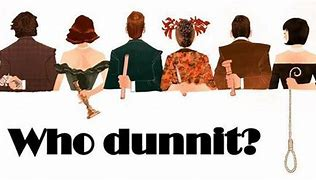What makes a good mystery?
Mystery novels have been entertaining readers since the 19th century. Why have they endured for so long? Quite frankly, because they are good, solid entertainment. Who doesn't love trying to solve the crime before the big reveal? It is one of the greatest pleasures of reading a mystery--the idea that we, as the reader, are smart enough to see through the red herrings, pick up on the real clues, and solve the case before the detective. It is a feeling one can only experience through the capable hands of a good mystery writer. As a reader, I enjoy becoming immersed in the story and taking on the same challenge the protagonist is facing when putting the facts and clues together as the story unfolds. It actually becomes a race against the clock-- who will solve the case first, me or the detective?
There are all types of mysteries. My personal favorite is the murder mystery--especially the locked-room variety (more on that later). But a mystery doesn't have to revolve around a dead body. The mystery could center around a theft, a missing person, a kidnapping, a con artist, someone being framed, or a multitude of other crimes. As long as the basic formula is there--a crime is committed by a bad guy (antagonist), a sleuth in some form (protagonist) tries to solve the crime, lots of clues and red herrings sprinkled throughout, some suspenseful cat and mouse play between the two sides, a plot twist, and plenty of tense moments eventually leading to a climax that produces a satisfying ending--it can all fall under the mystery genre.
And then there's the caper mystery. This is a unique style where the traditional formula is flipped--think Ocean's Eleven--In this style of mystery, the reader has full acknowledgment of who is committing the crime from almost the beginning. There is usually more than one criminal, each with a specialized skill, that have banded together and are all working as a team alongside the criminal mastermind. The story mostly revolves around the planning and execution of the crime. The police or detectives are often portrayed as inept and are usually a few steps behind. The satisfaction for the reader of this type of mystery comes in the form of figuring out the why behind the elaborate scheme. We already know who the players are, but why are they attempting to pull off the crime? It is more of a WHYDUNNIT, thus the idea that the classic mystery formula has been flipped.
The classic WHODUNNIT was built by the likes of Agatha Christie, Dashiell Hammett, Raymond Chandler, Rex Stout, Sir Arthur Conan Doyle, and of course, Edgar Allan Poe, who even has an award named after him--The Edgar Allan Poe Awards, referred to as The Edgar, are presented each year to the most deserving authors and producers of mystery fiction, non-fiction and television by the Mystery Writers of America, an organization for professional mystery and crime fiction writers.
And standing on the shoulders of these pioneers, bringing the mystery genre into the twentieth century and beyond are authors like Michael Connelly, P.D. James, Jeffery Deaver, Lawrence Sanders, Robert B. Parker, Lawrence Block, James Patterson, Rita Mae Brown, and so many others. Some of these writers have taken elements from the classics and updated the way they devise the plot and the characters. But that same basic formula is still there, underneath the modern tech world you'll find the heartbeat of a classic mystery.
As I mentioned before, I like a good 'Locked-Room' mystery. I think they are some of the all-time best mystery stories ever written and can really test the reader's ability to solve the mystery before the big reveal.Here is how Wikipedia describes this classic mystery sub-genre: The "locked-room" or "impossible crime" mystery is a type of crime scene in crime and detective fiction. The crime in question, typically murder ("locked-room murder"), is committed in circumstances under which it was seemingly impossible for the perpetrator to commit the crime or evade detection in the course of getting in and out of the crime scene. The crime in question typically involves a crime scene with no indication as to how the intruder could have entered or left; for example, a victim found deceased in a windowless room that is sealed from the inside at the time of discovery. Following other conventions of classic detective fiction, the reader is normally presented with the puzzle and all of the clues and is encouraged to solve the mystery before the solution is revealed in a dramatic climax.
If you want a taste of how much fun a locked room mystery can be, one of the best collections out there is The Black Lizard Big Book of Locked-Room Mysteries. This book is huge - it contains 68 mysteries. Edited by Otto Penzler, it is one of the most complete collections of impossible crime stories ever assembled, with puzzling mysteries by Stephen King, Dashiell Hammett, Lawrence Block, Agatha Christie, Georges Simenon, Dorothy L. Sayers, P. G. Wodehouse, and Erle Stanley Gardner, just to name a few.
You can check it out here: Amazon
So, what makes a good mystery? I guess that depends on what you're most interested in. I suggest you begin with the classics, the original OG, as it were, and then branch out from there. My guess is that wherever you start your mystery journey, you will quickly get lost in some amazing stories. Keep in mind, the mystery genre has been popular for nearly 200 years... and with very good reason. 😎
______________________________
Meanwhile, feel free to enjoy a mystery written by yours truly😉
Just click here for info on how to find my books: Tony Razzolito, PI
Until next time...


